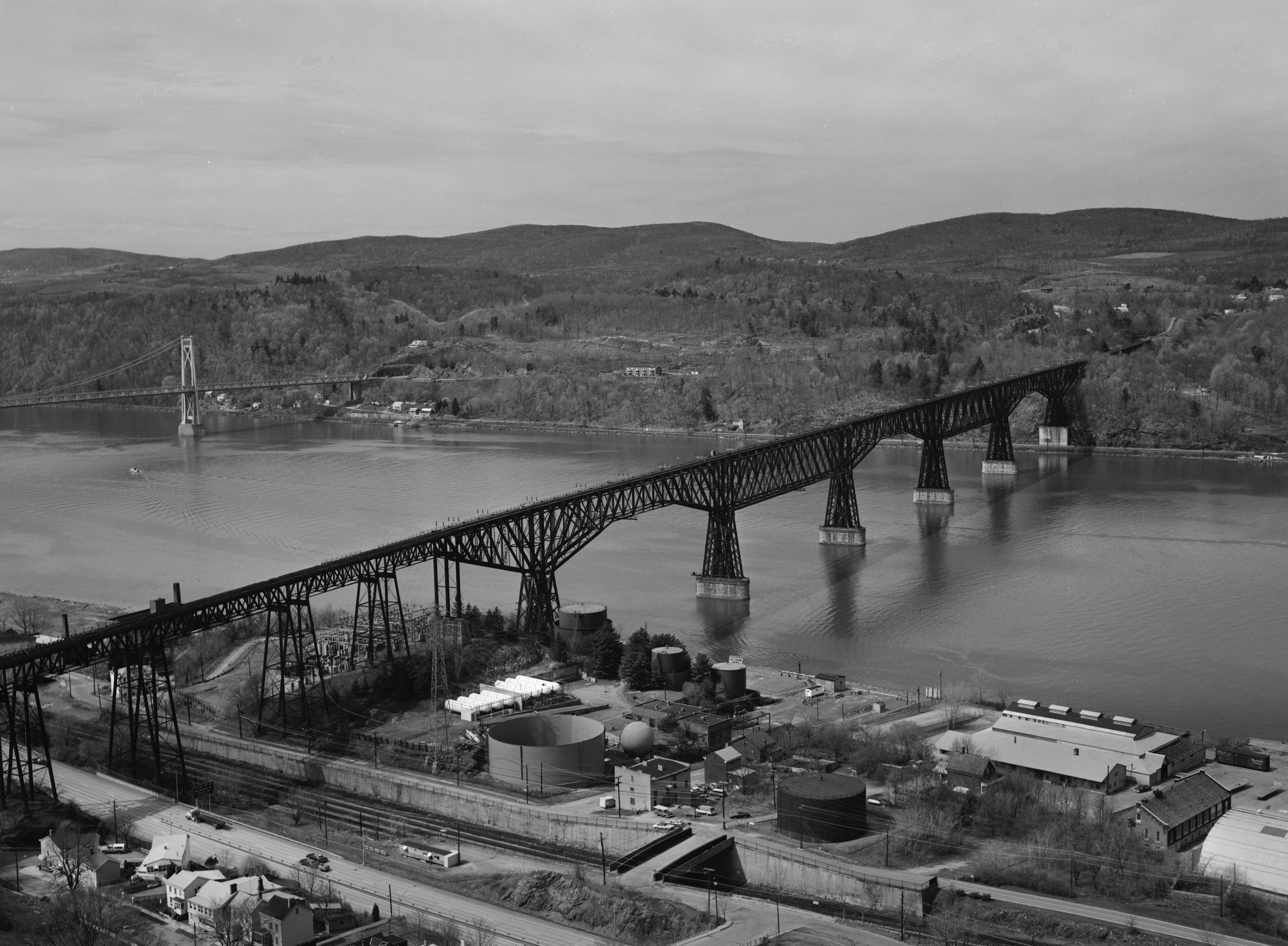Poughkeepsie Bridge (Railroad): Fire, History, Walkway
Last revised: August 24, 2024
By: Adam Burns
The Poughkeepsie Bridge, also known as the Walkway Over the Hudson, is a steel cantilever bridge spanning the Hudson River between Poughkeepsie, New York, and Highland, New York.
The bridge was originally built as a double track railroad bridge in 1889, but was converted into a pedestrian walkway in 2009. It is notable for being the world's longest elevated pedestrian bridge, offering stunning views of the Hudson River and the surrounding landscape.
The bridge is one of New England's most famous landmarks. However, despite the structure's size and length it was not constructed by any major railroad of the time.
The structure became an important link for smaller, regional systems like the New Haven, Lehigh & New England, Lehigh & Hudson River, Jersey Central, and others to handle through traffic between New England and the Midwest.
After the New Haven joined Penn Central on January 1, 1969, the bridge became redundant and it was finally sold off by Conrail. Unfortunately, there is a great deal of controversy surrounding the structure.
In 1974 Penn Central was on the cusp of collapse following its bankruptcy four years earlier. The company was destitute and attempted to eliminate as many money losing operations as possible. The Poughkeepsie Bridge was one such asset the conglomerate no longer needed.
It mysteriously caught fire in the spring of 1974, rendering the structure unusable. The railroad was often blamed for the fire since it failed to maintain the bridge's fire monitoring system, which included barrels of water and a watchman.
Today, the bridge is owned by the New York State Office of Parks, Recreation and Historic Preservation and was opened to the public in the fall of 2009 as the Walkway Over the Hudson State Historic Park.
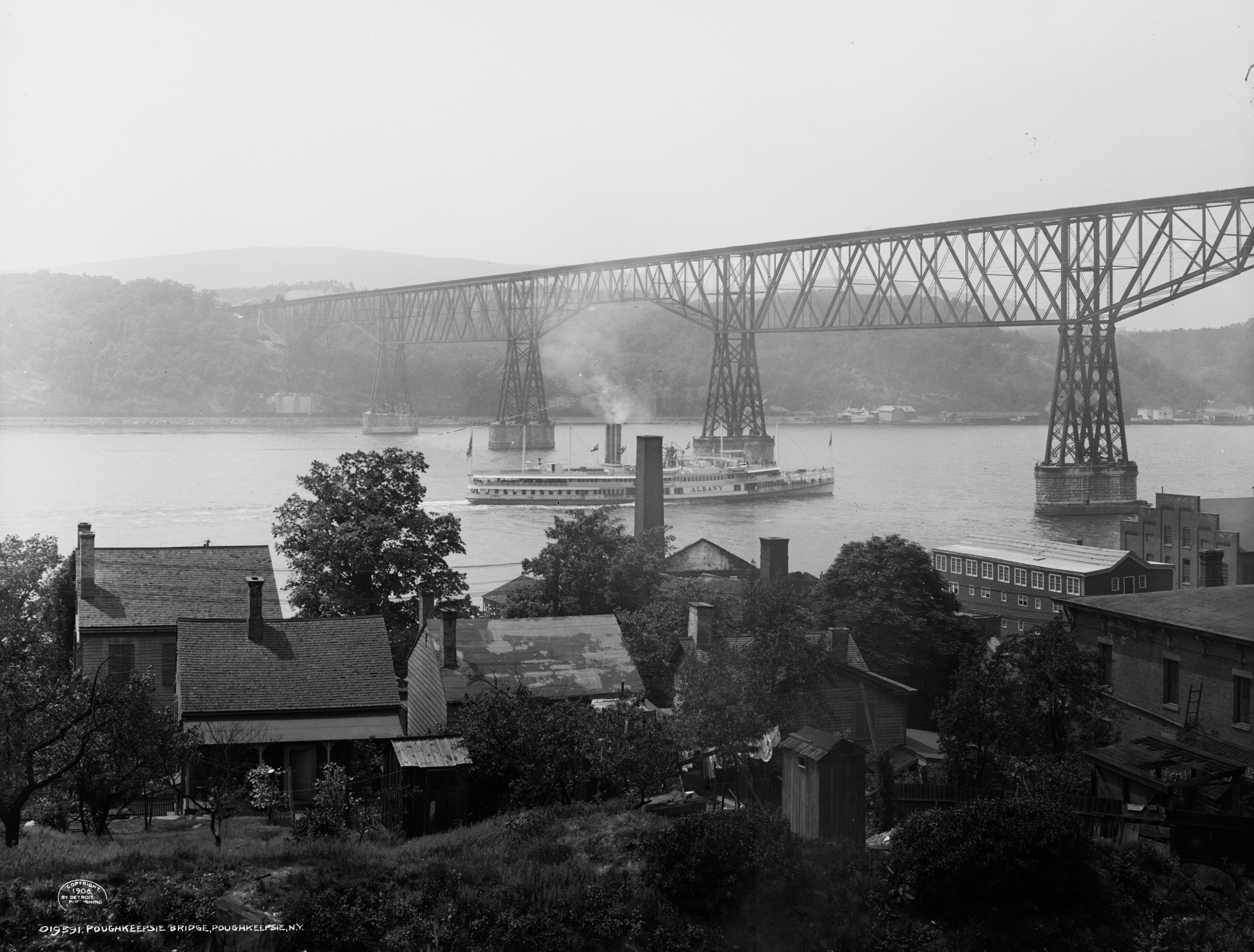 The Detroit Publishing Company took many high quality photographs during the 19th and early 20th centuries which are now greatly valued for their historical importance. Seen here is the Poughkeepsie Bridge looking to the northwest, circa 1906.
The Detroit Publishing Company took many high quality photographs during the 19th and early 20th centuries which are now greatly valued for their historical importance. Seen here is the Poughkeepsie Bridge looking to the northwest, circa 1906.History
Initiating the chronicle of the Poughkeepsie Bridge, it is essential to understand its conception. By the mid-19th century industrialization spearheaded demand for better composure of the transportation system.
The need for a bridge in Poughkeepsie was propelled by the strategic possibility of connecting Pennsylvania coal with New England industrial centers, hence eliminating the long detour around the southern tip of New York.
The idea for what would become the Poughkeepsie Bridge dates as far back as 1855. However, the plan was ridiculed for years as too expensive and redundant. The first true attempt to construct a bridge began with the Poughkeepsie Bridge Company chartered in June, 1871 that was to be financed by the Pennsylvania Railroad.
However, the Panic of 1873 stalled the plan. Fifteen years later, the Manhattan Bridge Building Company was formed in 1886 to revive the project in 1886. It was well-funded nonetheless with powerful names like Andrew Carnegie behind the project.
Construction
The monumental task of designing and construction lay on the shoulders of distinguished engineer Charles McDonald and Arthur Paine, associated with the Union Bridge Company.
With funding secured the bridge was completed in just two years, in late December, 1888, and opening on the first day of January, 1889. It featured a cantilever design and was constructed entirely of steel, save for its concrete supports.
The bridge stretched 6,767 feet across the sparkling Hudson River. At an imposing height of 212 feet (64.6 meters) above the water, it became an engineering marvel of its age, designed to resist the harsh conditions of weather and weight.
The entire project had an estimated cost of $2.6 million dollars, a significant amount considering the time when it was completed, in 1889.
Specifications
| Length | Height | Number Of Spans | Type | Engineers | Designers |
|---|---|---|---|---|---|
| 6,767 Feet | 212 Feet Above The Water Line | 7 | Steel Cantilever/Truss | Dawson, Symmes & Usher Company and John O'Rourke, P. P. Dickinson | Charles Macdonald and Arthur Paine |
Interestingly, the Poughkeepsie Bridge Company, which owned the bridge relied on new railroads to build east and west to link it with the national network.
These companies began as the Hudson Connecting Railroad, chartered in 1887 to build southwestward from Poughkeepsie while the Poughkeepsie and Connecticut Railroad was chartered the same year to build northeastward.
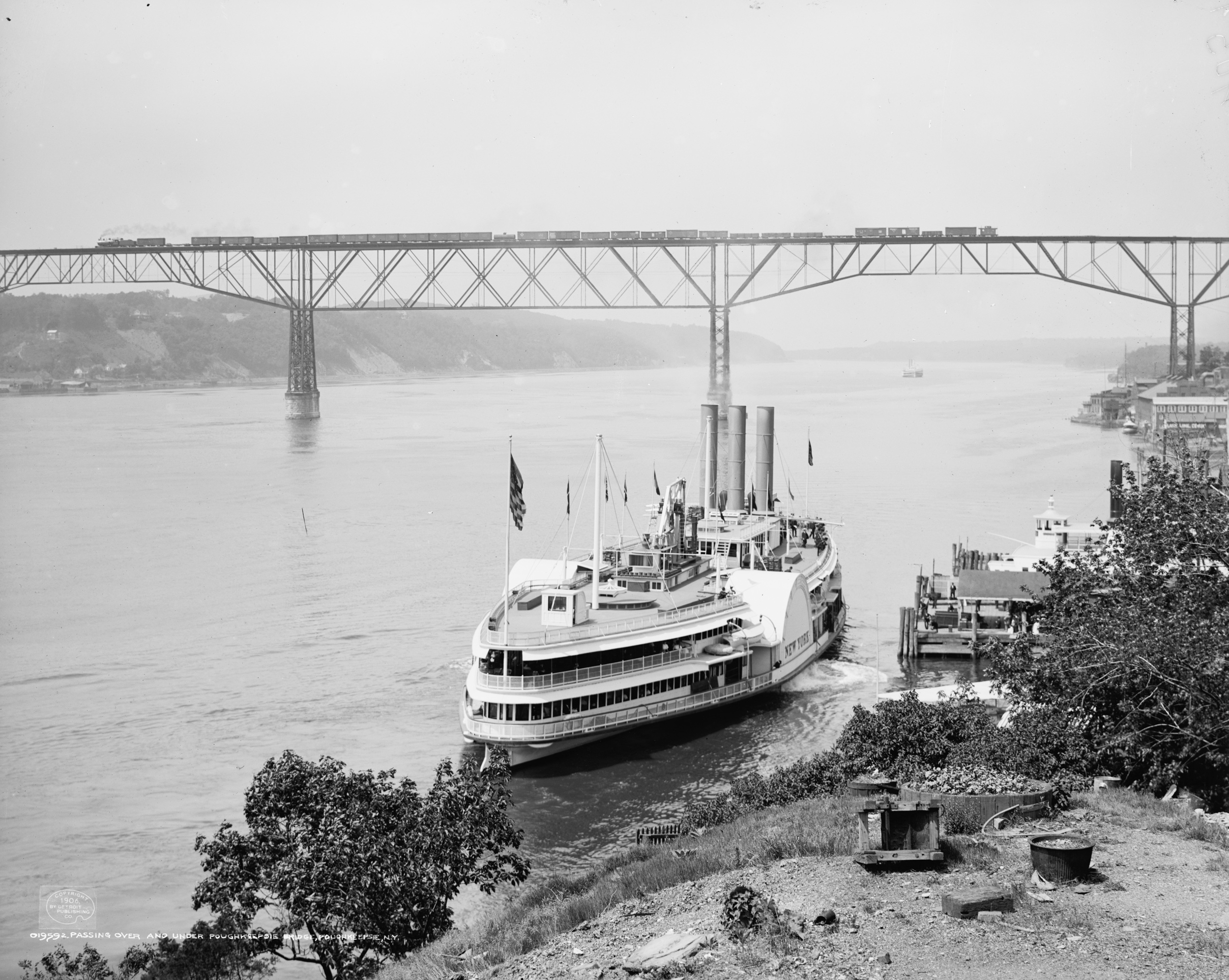 Looking directly north up the Hudson River we see a short, westbound freight train passing over the Poughkeepsie Bridge. To the right, along the river's east bank, but just out of view is the New York Central's "Water Level Route" main line.
Looking directly north up the Hudson River we see a short, westbound freight train passing over the Poughkeepsie Bridge. To the right, along the river's east bank, but just out of view is the New York Central's "Water Level Route" main line.Operation
In July of 1889, seven months after the bridge opened the Central New England & Western Railroad was created to merge the three into a single, continuous route which stretched from Hartford, Connecticut to Maybrook, New York.
In 1892 the Philadelphia & Reading (the Reading) acquired the CNE&W. However, the financial Panic of 1893 resulted in the Reading's bankruptcy and it lost control of the railroad.
The CN&EW was subsequently reorganized as the Central New England Railway. The CNE remained in operation from 1899 until it came under the control of the New York, New Haven & Hartford (New Haven) in 1927, in which it remained until the creation of Penn Central.
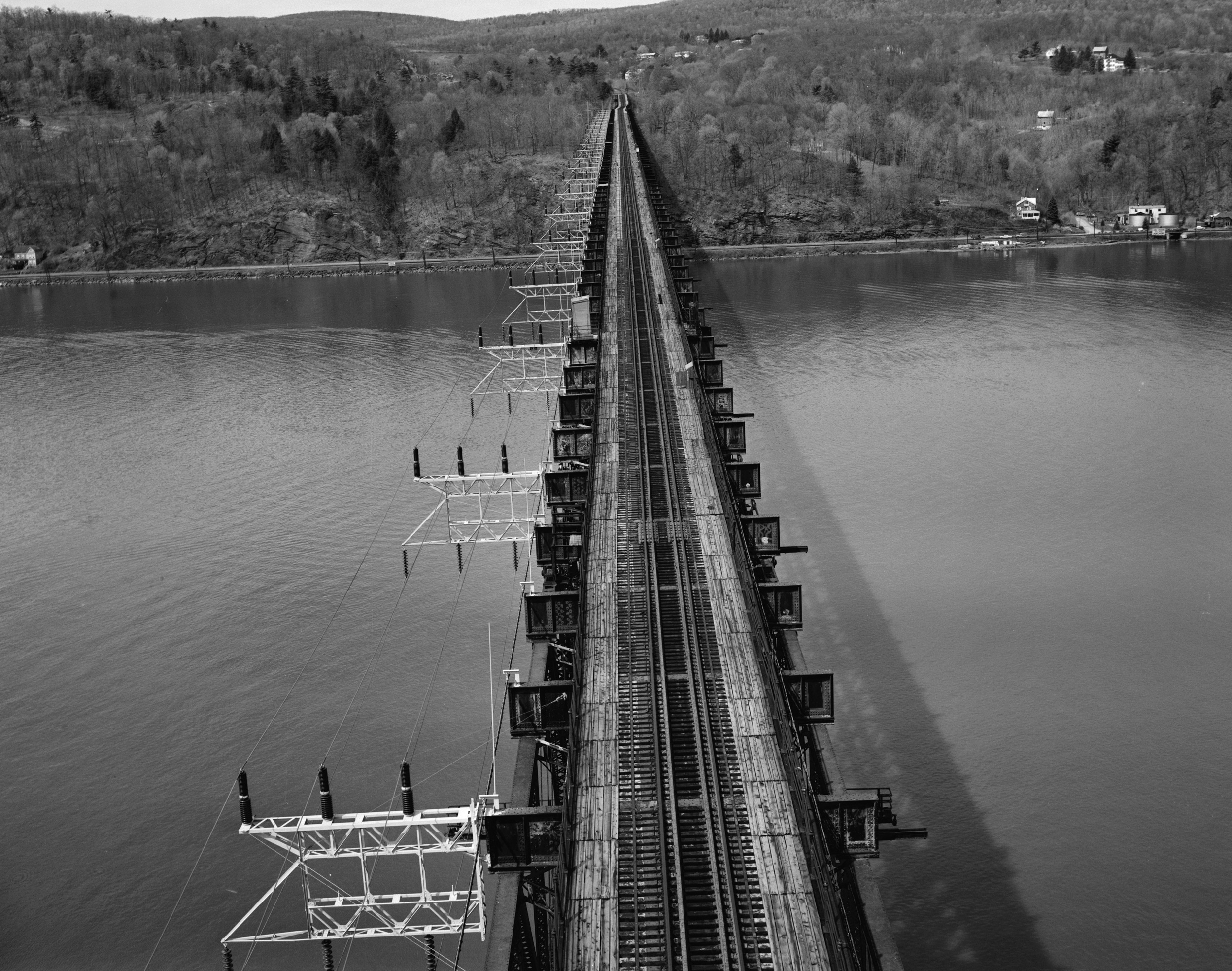 An undated, aerial view of the Poughkeepsie Bridge looking directly west. This scene appears to have been taken prior to the span's 1974 fire incident when rail service ceased.
An undated, aerial view of the Poughkeepsie Bridge looking directly west. This scene appears to have been taken prior to the span's 1974 fire incident when rail service ceased.Prior to the formation of the Erie-Lackawanna (EL) in 1960 virtually all of the smaller New England Class I's relied on the Poughkeepsie Bridge to ferry freight and passenger traffic between New England and points west and south such as Buffalo, Philadelphia, Pittsburgh, Chicago, and Indianapolis.
These companies included the Lackawanna/EL, Erie/EL, Lehigh & New England, Lehigh & Hudson River, Jersey Central (CNJ), and even the Reading (which often ferried traffic to and from the CNJ).
After the EL merger the new company elected to keep most Chicago-bound freight on its own rails. However, the bridge still offered an important interchange point for New England-bound traffic carried by the Boston & Maine and New Haven. When the bridge closed in 1974 all of the railroads which had relied on the structure felt the effects.
Penn Central
The bridge saw less traffic after the creation of Penn Central in 1968 as that railroad chose to likewise keep freight on its own rails rather than transferring it to other lines.
The situation was further complicated by Penn Central's declining financial state and worsening deferred maintenance, system wide. Then, an arsonist's fire on May 8, 1974 forced the bridge's closure and the PC elected not to fund repairs.
This closure forced the Lehigh & Hudson River into bankruptcy as the railroad relied completely on the bridge for freight.
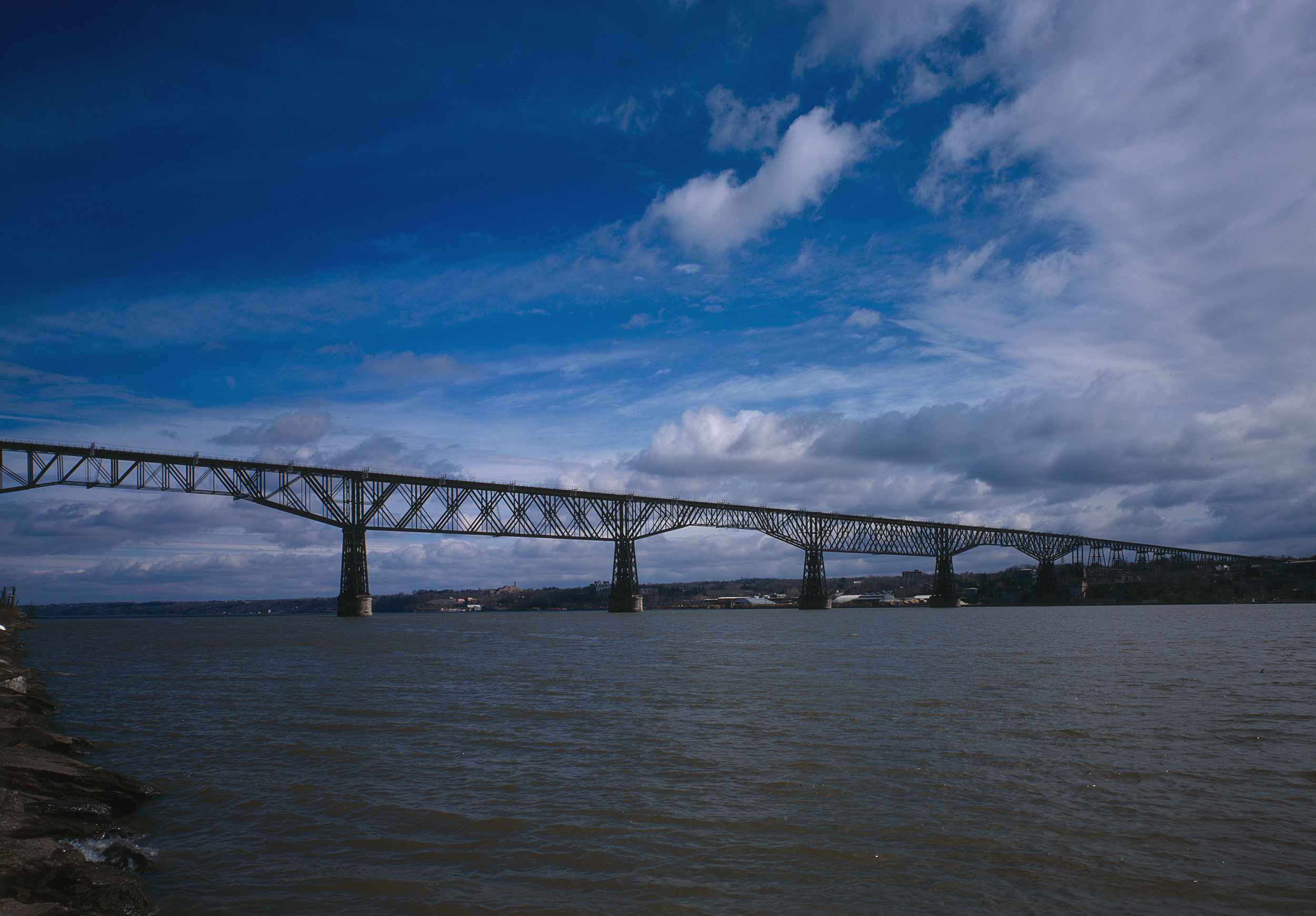 A northeasterly view of the Poughkeepsie Bridge, taken from the Hudson River's west bank, circa 1986. By the date of this photo the span had been out of service for twelve years. Jet Lowe photo.
A northeasterly view of the Poughkeepsie Bridge, taken from the Hudson River's west bank, circa 1986. By the date of this photo the span had been out of service for twelve years. Jet Lowe photo.Walkway Over The Hudson
In 1976 the bridge passed into the hands of Conrail, which had no use for the structure.
In late 1984 it was sold to Gordon Schreiber Miller and later Vito Moreno, both of which did nothing with the bridge. Fourteen years later it was sold again to the Walkway Over the Hudson non-profit group aimed to repurpose the structure as a pedestrian footbridge.
After millions of
dollars either granted, raised, or donated the bridge opened to the public on October 3, 2009. To visit the Walkway's website please click here.
Recent Articles
-
Virginia Wine Tasting Train Rides
Jul 07, 25 10:45 PM
Wine tasting trains in Virginia provide just that—a unique experience that marries the romance of rail travel with the sensory delights of wine exploration. -
Vermont Wine Tasting Train Rides
Jul 07, 25 10:39 PM
Known for its stunning green mountains, charming small towns, and burgeoning wine industry, Vermont offers a unique experience that seamlessly blends all these elements: wine tasting train rides. -
Indiana's Whiskey Train Rides
Jul 07, 25 10:31 PM
Whether you're a local resident or a traveler looking to explore Indiana from a unique perspective, hopping on a whiskey train ride is a journey worth considering.
